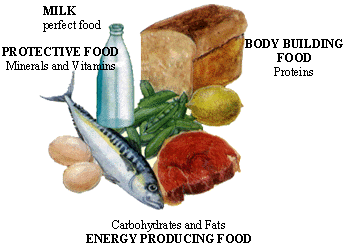|
PinkMonkey Online Study Guide-Biology
16.1 Nutritional requirements, imbalances and deficiency diseases
Constituents of Food
The chief constituents of food are : (a) carbohydrates, (b)
proteins, (c) fats and oils, (d) vitamins, (e) minerals, (f) water, and
(g) roughage.
a) Carbohydrates : These
organic compounds are intimately involved in life processes. They contain
atoms C, H and O, the last two in the ratio 2:1. The general atomic composition
is stoichiometrically represented as C (H2O).
The simple sugars are the building blocks of carbohydrates. One gram of
carbohydrate provides about 4 Kcal of energy.
There are three types of carbohydrates :
(i) Monosaccharides : simple sugars
like glucose and fructose.
(ii) Disaccharides : double sugars like
maltose, sucrose, etc..
(iii) Polysaccharides : complex sugars
like starch, and glycogen.
Importance of carbohydrates in metabolism:
Carbohydrates like glucose form respiratory substrate or
fuel substances to produce energy. The excess of glucose is stored
in the liver and muscles (glycogen) in animals
and in the form of starch in plants. They are thus storage
compounds in plants and animals respectively. Cellulose and chitin
are carbohydrates which form structural materials for cell walls
in plants and exoskeletons in animals like arthropods.
Bread, potato, sugarcane, plantains, grapes and
cereals like wheat and corn are dietary sources of carbohydrates.
b) Proteins : These are the molecules which
are the fundamental compounds of protoplasm that are indispensable
for all life processes. Proteins contain "N" in addition
to C, H and O and may also contain phosphorus and sulphur. These
are the polymers of unit structures called amino
acids. A molecule of protein yields about 4 Kcal. of energy.
Meat, fish, eggs, peas, beans and milk contain
large amount of proteins.
 Figure 16.3 Constituents of food
Figure 16.3 Constituents of food
[next page]
|
Table of Contents
16.0 -
Introduction
16.1 -
Nutritional Requirements, Imbalances and Deficiency Diseases
16.2 -
Organs of Digestion and Physiology of Digestion
Chapter
17
|